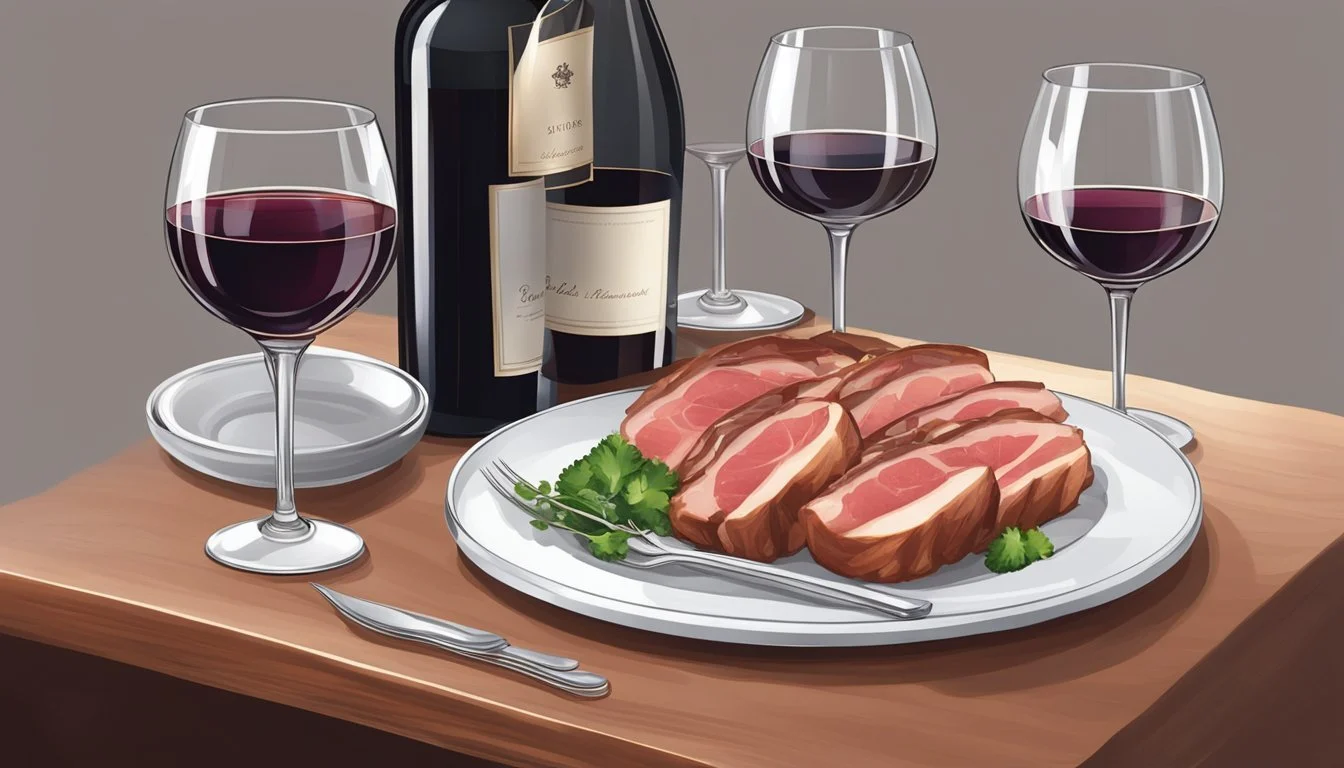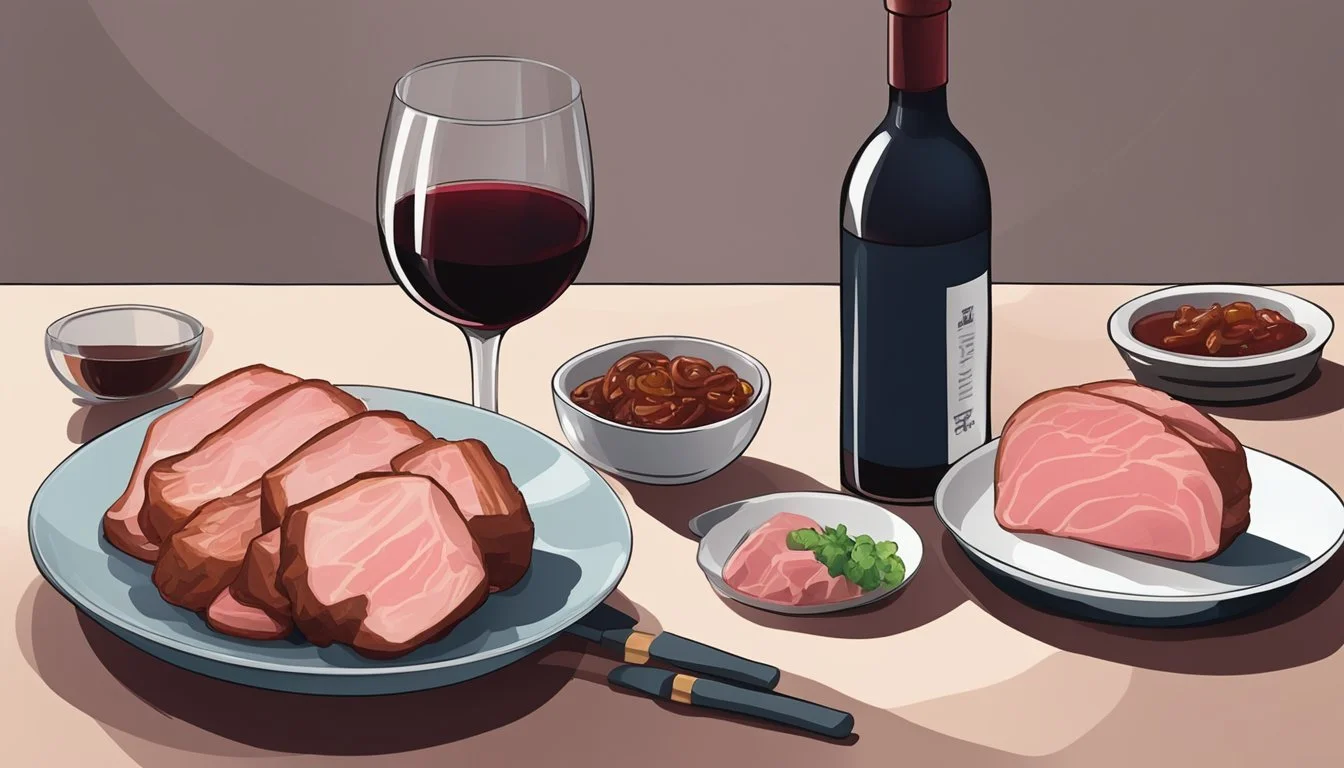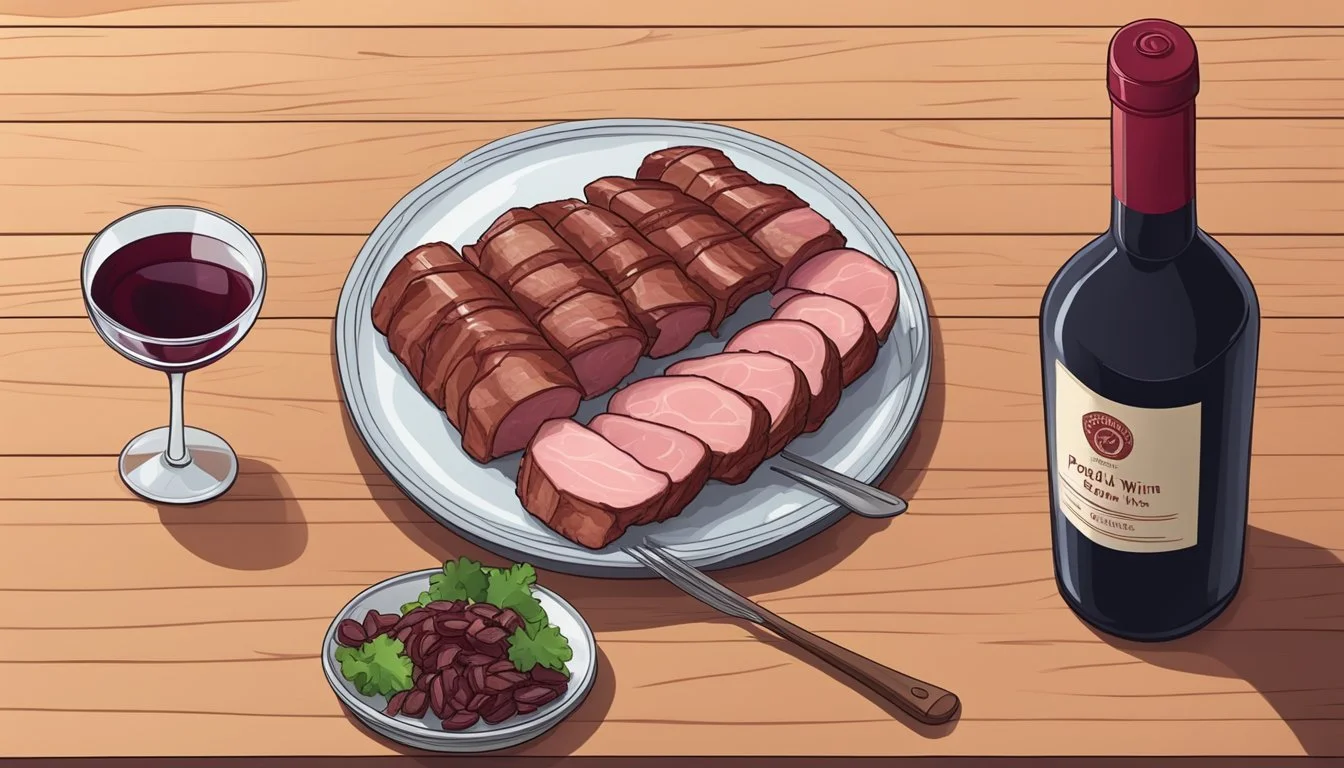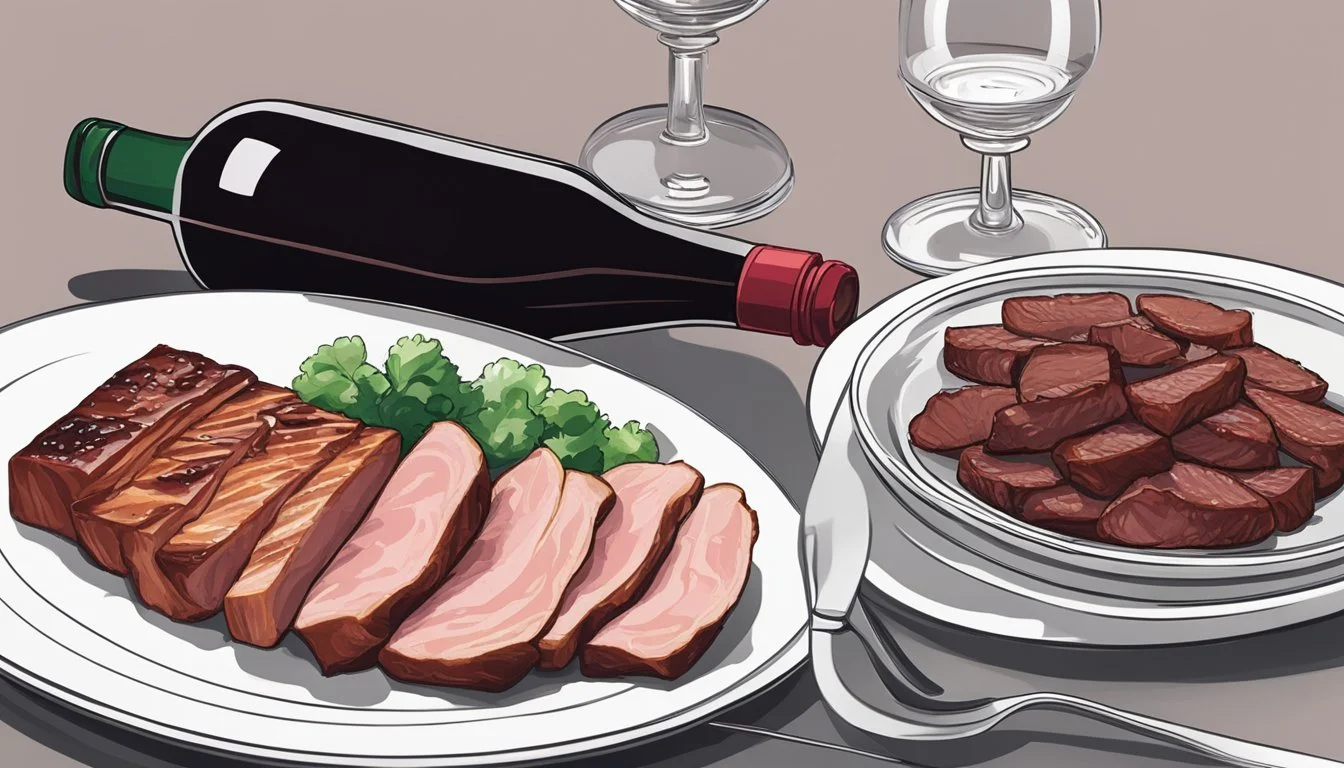What Wine Goes Well with Pork Char Siu?
Pairing Tips for a Perfect Meal
Pairing wine with pork, particularly char siu—a Cantonese style barbecue pork, requires considering the dish's unique flavor profile. Char siu is known for its rich sweetness, brought about by a marinade of honey, five-spice, soy sauce, and hoisin. This sticky glaze pairs well with wines that complement its sweet and savory balance.
A suitable wine pairing enhances both the dish and the wine itself. For char siu, a wine's acidity should cut through the dish’s fattiness, while subtle smokiness or fruitiness can echo its marinade and cooking method. A full-bodied Pinotage, with its smoky and fruity undertones, or a smooth, refreshing Pinot Grigio can pair splendidly, offering a palate cleanser that matches the weight of the meat without overwhelming its complex flavors.
It is also useful to explore slightly off-dry Rieslings or even a Zinfandel, as they have the necessary acidity to contrast the pork's sweetness while supporting the meal’s intensity. Pairing wine with char siu pork can elevate the dining experience, making each aspect of the meal more enjoyable.
The Basics of Char Siu
Char Siu refers to a traditional Cantonese style barbecue pork that is renowned for its savory sweetness and distinctive red hue. This dish is a staple in Chinese cuisine and enjoys popularity across various regions for its unique flavors.
Origins and Cultural Significance
Char Siu, literally meaning "fork roast," has its roots deeply embedded in Cantonese culture. It is traditionally cooked on a fork over a fire, which is how it gets its name. This method of slow-roasting allows the pork to acquire a smoky flavor while the sweet marinade creates a glossy, caramelized exterior. The dish is a common sight in Chinese street markets and is a favorite in dim sum as well as being a key component in many other Asian dishes.
Key Ingredients
The flavor profile of Char Siu comes from a combination of several key ingredients:
Soy Sauce: Provides the saltiness and umami flavor.
Hoisin Sauce: Adds a sweet and slightly tangy taste.
Honey or Maltose: Offers sweetness and aids in caramelization.
Sesame Oil: Gives a subtle nuttiness and fragrance.
Chinese Five Spice Powder: A blend that typically includes star anise, cloves, Chinese cinnamon, Sichuan pepper, and fennel seeds, contributing a deep aromatic element.
Brown Sugar: Enhances the sweetness and helps in creating a sticky glaze.
Garlic: Adds depth and a piquant kick to the marinade.
The marinade, which can be enriched with ingredients like oyster sauce for more complexity, often includes red food coloring to achieve Char Siu's signature appearance. The pork is thoroughly marinated, sometimes overnight, ensuring the flavors penetrate deeply. After marinating, it's barbecued until the edges are charred and the meat is tender, resulting in a dish that has a perfect balance of sweet, savory, with a hint of smokiness.
Preparation of Pork Char Siu
Creating the perfect Pork Char Siu (What wine goes well with pork char siu?) involves careful selection of meat, a flavorful marinating process, precise cooking techniques, and proper resting for a succulent finish.
Selecting the Right Cut
The cut of pork is decisive for Char Siu. Pork shoulder is often preferred for its fat content which ensures a tender outcome. Alternatively, pork belly (What wine goes well with pork belly?) can provide a richer flavor and pork tenderloin (What wine goes well with pork tenderloin?) is a leaner option that cooks quickly. One should avoid pork chops (What wine goes well with pork chops?) as they are less suitable for the long marinating and cooking process required for Char Siu.
Marinating Process
Marinating is crucial for infusing the pork with rich flavors. Typically, one combines ingredients such as soy sauce, hoisin sauce, a sweetening agent like honey, Chinese five spice, and white pepper to create the marinade. For deeper flavor, it's recommended to marinate the pork for at least 1 hour, though overnight in the refrigerator will yield the best results. It's essential to reserve some of the marinade for basting during the cooking process.
Cooking Techniques
Char Siu should be roasted slowly in the oven to achieve a tender texture and caramelized exterior. Preheat the oven to a moderate temperature, usually between 300°F and 375°F. Place the marinated pork on a baking tray lined with foil and set on a wire rack to ensure even cooking. Regular basting with the reserved marinade is important for developing a sticky, sweet glaze. Utilize a thermometer to monitor the internal temperature and ensure proper doneness.
Finishing Touches and Resting
Once the pork's exterior is suitably caramelized and the internal temperature reaches the desired level, usually around 145°F for cuts like tenderloin and 160°F for shoulder or belly, the Char Siu is almost ready. Before slicing, allowing the meat to rest is paramount. This pause lets the juices redistribute, rendering the pork more succulent. A rest period of about 10 to 15 minutes covered loosely in foil should suffice. During resting, the carryover cooking will bring it to a safe and perfect finish.
Serving and Pairing
When serving char siu, the choice of wine should enhance the sweet and savory profile of the dish without overwhelming its complex flavors.
Ideal Accompaniments
Char siu is typically enjoyed with a variety of accompaniments that can influence the wine pairing. Rice is a classic side, providing a neutral backdrop that allows the flavors of char siu to shine. For a richer option, pork fried rice includes bits of char siu and can be paired with a wine that cuts through the fattiness and complements the umami flavors.
Char siu bao, or BBQ pork buns, combine the sweetness of the pork with a soft, slightly sweet dough. Selecting a wine with enough acidity is critical to balance the richness of the bun.
Other Chinese dishes that pair well with char siu include dumpling varieties and distinct fried rice recipes. Wines chosen should harmonize with the common threads of sweetness and spices present in these dishes, without overshadowing their unique characteristics.
Wine Pairing with Pork Char Siu
A perfect wine pairing can elevate the flavors of Pork Char Siu, which is known for its sweet, savory, and slightly smoky taste profile. Selecting a wine that complements the rich umami and the honeyed glaze of the dish is crucial.
Understanding Wine Characteristics
When selecting a wine to accompany Pork Char Siu, it's important to consider its characteristics such as acidity, tannins, and body. A good pairing will balance the dish's sweetness and complement its flavors. Wines with moderate tannins and a bright acidity can cut through the richness of the pork while harmonizing with its sweetness and aromatic spices.
Red Wine Options
For red wines, the aim is to find a variety with enough fruitiness and a delicate balance of tannins to match the dish's flavors without overpowering it.
Pinot Noir: With its fruity notes and moderate tannins, it pairs well with Char Siu's sweetness.
Zinfandel: If the Char Siu is on the spicier side, the boldness of a Zinfandel can be a good match.
Beaujolais: Light-bodied with high acidity, Beaujolais can refresh the palate between bites.
White Wine Selections
White wines, particularly those with a good acidity level, can offer a refreshing contrast to the richness of Pork Char Siu.
Riesling (off-dry): The wine's sweetness complements the honeyed glaze of Char Siu.
Chardonnay: Opt for a less oaky Chardonnay to avoid clashing with the pork's flavors.
Chenin Blanc (Vouvray): A semi-sweet Vouvray balances the sweet and savory components with its high acidity and fruitiness.
In essence, whether red or white, the chosen wine should offer a palate-cleansing effect while resonating with the complexity of Char Siu's flavors.
After The Meal
When the delightful experience of pairing wine with Char Siu comes to an end, one should consider the best practices for handling leftovers to extend the enjoyment of this dish.
Storing Leftovers
Leftover Char Siu should be stored properly to maintain its quality. It can be kept in the refrigerator for up to four days when sealed in an airtight container. For longer storage, one can freeze Char Siu; wrap it tightly with heavy-duty aluminum foil or place it in a freezer bag, and it will retain its flavor for up to two months. Before storing, however, one should coat the Char Siu with a light layer of Char Siu sauce to keep it moist.
Creative Uses for Leftover Char Siu
Leftover Char Siu opens the door to culinary creativity. Here are a couple of suggestions:
Char Siu Fried Rice: Cube the Char Siu and stir it into fried rice, adding a tantalizing BBQ flavor to this classic dish.
Char Siu Omelette: Enhance a breakfast omelette by filling it with slices of Char Siu, offering a sweet and savory start to the day.
Culinary Tips and Tricks
Selecting the right wine for char siu pork involves understanding the dish's balance of savory sweetness and aromatic spices. Chefs recommend considering the intensity of the barbecue sauce and the cooking method used to achieve the best pairing.
Expert Advice from Chefs
American and Singapore chefs agree on the importance of pairing wines that can stand up to the bold flavors of Chinese barbecue pork. A chef might suggest a slightly sweet Riesling or a full-bodied Zinfandel to complement the sweet and savory notes of the char siu's sauce. Others may advise a Pinot Noir for its fruitiness that cuts through the richness without overshadowing the delicacy of the pork.
Wine Type Characteristic Reason for Pairing Riesling Slightly sweet; aromatic Balances savory-sweet sauce; refreshes the palate Zinfandel Full-bodied; fruity Stands up to the bold flavors; complements spices Pinot Noir Light; fruity Cuts through richness; does not dominate pork flavor
DIY Barbecue Sauces and Marinades
Chefs recommend experimenting with DIY barbecue sauces and marinades to tailor the flavors to one's personal palate, which can also influence wine choice. A homemade barbecue sauce might include a variety of ingredients—hoisin for a traditional touch, or a splash of bourbon for an American twist.
Sauce Ingredients:
Hoisin: Adds depth and authenticity
Bourbon: Infuses an American flair
When preparing the marinade, chefs underscore the need for balance. A sauce that is too sweet might clash with a sweet wine, while a more vinegar-based sauce could pair well with a vibrant, acidic wine. The barbecue sauce amplifies the dish's flavor profile—ensure it is thick and syrupy for a proper glaze that caramelizes well during cooking.
Health Considerations
When considering what wine to pair with char siu pork, it's essential to account for the dish's nutritional components, particularly its fat and salt content. These factors can influence both the choice of wine and the dietary considerations of the individual.
Nutritional Information
Char siu is known for its rich flavors, often achieved by using ingredients like honey, soy sauce, and hoisin sauce. These contribute to its sweetness and savoriness. However, they also add to the overall fat and sodium content. Since char siu is usually made from pork which contains a higher level of saturated fat, it's important to consider the implications for heart health.
Typical Nutritional Values per 100g of Pork Char Siu:
Calories: 300-400 kcal
Total Fat: 10-15g
Saturated Fat: 3-5g
Sodium: 800-1000mg
Considering these values, one should be mindful of portion sizes and frequency of consumption.
Dietary Adjustments
Individuals who are monitoring their fat or sodium intake for health reasons should consider making modifications to the recipe or choosing appropriate portion sizes. For those on a low-sodium diet, reducing the soy and hoisin sauce or opting for low-sodium alternatives can be beneficial. Additionally, opting for leaner cuts of pork can decrease the saturated fat content.
When pairing with wine, a drier variety with higher acidity may help to balance out the fatty richness of the pork and cut through the sweetness. Individuals should select wines that align with their dietary restrictions, such as those lower in alcohol for reduced calorie intake or eliminating sulfites if sensitive to them.








